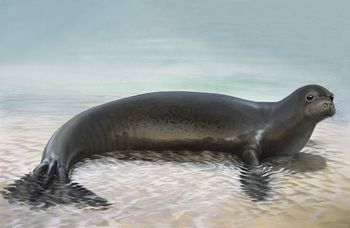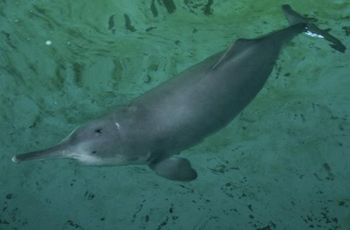ExtinctMammals: Difference between revisions
| Line 38: | Line 38: | ||
This imbalance can spell disaster for ecosystems. For example, if grazing fish populations are decimated, this will result in a decrease in the animals that feed on those fish and an increase in the amount of algae, which can cover coral and eventually kill it. | This imbalance can spell disaster for ecosystems. For example, if grazing fish populations are decimated, this will result in a decrease in the animals that feed on those fish and an increase in the amount of algae, which can cover coral and eventually kill it. | ||
<ref name="Habitat Loss"> Munday PL. 2004. Habitat loss, resource specialization, and extinction on coral reefs Global Change Biology. Global Change Biology 10:1642–1647.</ref> | <ref name="Habitat Loss"> Munday PL. 2004. Habitat loss, resource specialization, and extinction on coral reefs Global Change Biology. Global Change Biology 10:1642–1647.</ref> | ||
=== On Humans === | |||
The extinction of marine mammals mainly impacts humans through the degradation of the ecosystems in which they live. By taking out key players in a food web, an ecosystem will suffer, as will the human communities that rely on those ecosystems for life. This would have economic consequences in terms of tourism and fishing industries. <ref name="Endangered Species".Marshall, Michael. "What Is the Point of Saving Endangered Species?" BBC Earth. The British Broadcasting Network, 14 July 2015. Web. 19 Apr. 2016.</ref> | |||
== Connection to Coral Reefs == | == Connection to Coral Reefs == | ||
Revision as of 21:06, 19 April 2016
Extinct Marine Mammals
Throughout history, many animals have became extinct through different stressors and some due to lack of evolving traits to keep up with those stressors. The marine mammals focused and exploited in this era have led to several species to die out and be bottlenecked through new and old causes. Recently, in the last 100 years, the Caribbean Monk Seal, Japanese Sea Lion, and Baiji have all been ushered to extinction.
Past Extinctions
Caribbean Monk Seal

The Caribbean Monk seal is among the most intriguing caribbean mammal to investigate and analyze through their extinction. The seals are very closely related to the Hawaiian and Mediterranean Monk Seals. The last sighting of a Caribbean monk seal was in 1952 off of Serranilla Bank in Jamaica. The seals were believed to be hunted to extinction for their oils, from the blubber, and became a food source for the locals. It was finally declared that the seals were extinct in 1986 after not one had been sighted in over 34 years. Although overfishing was an easy stressor to identify for these mammals, other stressors such as climate and ocean change as well as habitat destruction contributed to the seals decline. [2]
Japanese Sea Lion

The Japanese Sea Lion (Zalophus Japonicus) was though to have become extinct around the 1970s. It is still considered a sub species of the California sea lion, yet some dispute among taxonomists has occurred as to whether this is true. The sea lions inhabited the Sea of Japan, especially between the Japanese Archipelago and Korean Peninsula region. The sea lions were of darker grey skin and could weigh upwards of 550 kg and reach lengths of near 2.5 m, this is larger than the current California sea lions. Sea lions were hunted for their valuable oils contained within their blubber and their internal organs were harvested for expensive oriental medicine. Their whiskers would even be used for pipe cleaners. Like many other marine mammals, overfishing and habitat destruction lead to their declines. The damages to habitats from submarine warfare in World War II was noted as a potential causer for the declining populations. To possibly rebuild the sea lion populations within Japan, governments have hypothesized bringing California sea lions and naturalizing them to the habitats in an effort to reestablish the sea lion populations within the area. [4]
Baiji

The Baiji (Lipotes Vexillifer) is a freshwater dolphin found in the Yangtze River in China. The Yangtze River is one of the most heavily populated areas in the entire world with over 12 % of the entire world living and working on the river. As a result, the Baiji were put under immense pressures from the industrial age that China is going through currently. The pollutants and destruction of the rivers habitats have caused a massive decline in the population in the last few decades, along with hunting of the dolphin and bycatch occurring, resulting in the Baiji becoming functionally extinct. Although this is different than being fully extinct, the Baiji has not been spotted in over 10 years and is most likely extinct, yet searches are still being done to fully conclude this information. The Baiji, if noted extinct, would become the first marine mammal completely documented to be brought to extinction through human stressors. Over half of the deaths from Baiji recorded were found to be because of entanglement in fishing gear and nets as well as illegal fishing practices such as dynamite and electrical fishing. 2004 was the last confirmed sighting and in 2006 a survey declared them extinct when no Baiji were reported in a population count. [6]
Causes
Many causes of marine mammalian extinction have been noted previously but to summarize and list several are as follows: coral bleaching, increasing ocean temperatures, overfishing, habitat destruction, and exploitation of the resources. [7]
Humans impact mammal populations mainly through the exploitation of marine resources. The loss of fish and other food sources from overfishing results in a decline in marine mammal populations. Additionally, the animals themselves are often caught as bycatch due to poor or nonexistent regulations on harvests.
However, the relationship between humans and marine mammals is not a black-and-white relationship. In order to create a solution to this urgent problem, the socioeconomic conditions of fishermen need to be taken into account. Poverty and the collapse of local fishing industries -- again, caused by overfishing -- can lead to abrupt changes in island economies.[8] In areas where poverty is especially prevalent, people will care more about putting food on the table than protecting dolphins or other creatures that, in many cases, they are in direct competition with for fish. In some cases, people have been known to feed dolphins dead fish stuffed with broken glass in order to eliminate this so-called competition. [9]
The collapse of fisheries has also led people to prey on marine mammals once their value as food and bait becomes apparent. In Peru, after the anchovy fisheries collapsed, people began hunting Peruvian dolphins, which they sold for their meat. This was unregulated and unsustainable, and led to the decimation of Peruvian dolphin populations. [8] An estimated 10,000 dolphins are killed each year for bait, despite the practice being illegal. [10]
There are two main ways that conservation groups and governments can go about trying to solve these issues. First, the issue of regulation versus deregulation needs to be addressed. No regulation leads to unsustainable practices, but for politicians advocating for regulation is political suicide. A medium needs to be found so that the needs of fishermen and their families are addressed, but marine mammal populations are not decimated in the process. [8] New and innovative solutions which can lessen a community's reliance on fishing and provide alternatives to mammal hunting can lead to less perceived competition between humans and animals.
Effects
On Ecosystems
The extinction of marine mammals is, in most cases, collateral damage that results from over-exploitation of marine resources and ecosystems. Although animals such as dolphins, otters, and seals suffer due to the disruption of trophic levels, the entire ecosystem in which that animal inhabits does as well.
Trophic levels, which represent different levels of the food chain, are disrupted by the world's fisheries in the form of overfishing. By capturing huge amounts of fish and essentially removing the energy and nutrients that those fish provide from the ecosystem, humans are causing changes to energy pathways and the amount of food available to other organisms in the environment. For many marine mammals, overfishing means that major food sources become either scarce or nonexistent. This causes a decrease in the numbers of apex predators such as killer whales and dolphins-- since less food means a smaller population of predators -- and an influx in species that the fish would have eaten.
This imbalance can spell disaster for ecosystems. For example, if grazing fish populations are decimated, this will result in a decrease in the animals that feed on those fish and an increase in the amount of algae, which can cover coral and eventually kill it. [11]
On Humans
The extinction of marine mammals mainly impacts humans through the degradation of the ecosystems in which they live. By taking out key players in a food web, an ecosystem will suffer, as will the human communities that rely on those ecosystems for life. This would have economic consequences in terms of tourism and fishing industries. Cite error: Invalid <ref> tag; invalid names, e.g. too many
[12]
References
- ↑ Digital image. N.p., n.d. Web. <http://insider.si.edu/2014/05/extinct-relative-reveals-rarity-last-two-remaining-monk-seal-species/>.
- ↑ (Nat. Hist) King, J. (1956). "The monk seals (genus Monachus)". Bull. Brit. Mus. (Nat. Hist) Zool. 3: 201–256.
- ↑ Digital Image. Web. <http://carnivoraforum.com/topic/9330844/1/>.
- ↑ Aurioles, D. & Trillmich, F. (IUCN SSC Pinniped Specialist Group) (2008). Zalophus japonicus. In: IUCN 2008. IUCN Red List of Threatened Species. Retrieved 29 February 2016.
- ↑ Digital Image. Web. <http://www.earthtimes.org/green-blogs/green-opinions/revisiting-sad-story-baiji-15-Aug-12/>
- ↑ Fisheries, NOAA. "Chinese River Dolphin / Baiji (Lipotes vexillifer) :: NOAA Fisheries". <http://www.fisheries.noaa.gov> Retrieved 29 February 2016.
- ↑ Institut de Recherche pour le Développement, Paris (IRD). (2008, November 3). Coral Bleaching Disturbs Structure Of Fish Communities. ScienceDaily. Retrieved February 29, 2016 from www.sciencedaily.com/releases/2008/10/081028132106.htm
- ↑ 8.0 8.1 8.2 Read AJ. 2008. The Looming Crisis: Interactions between Marine Mammals and Fisheries Journal of Mammalogy. Journal of Mammalogy 89:541–548.
- ↑ Dr. Gregory Gangi, comment made during presentation
- ↑ Rodriguez, Cindy Y., and Rafael Romo. "Dolphins Killed for Shark Bait in Peru." CNN, October 23, 2013. Accessed April 19, 2016. www.cnn.com.
- ↑ Munday PL. 2004. Habitat loss, resource specialization, and extinction on coral reefs Global Change Biology. Global Change Biology 10:1642–1647.
- ↑ Les Kauffman and Kenneth Mallory (eds).1984. Grew out of a public lecture series entitled 'Extinction: saving the sinking ark,' held in Boston, Massachusetts, at the New England Aquarium during the fall of 1984.